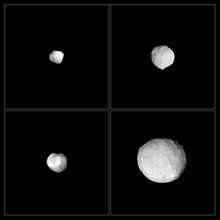89 Julia
.png) A three-dimensional model of 89 Julia based on its light curve. | |
| Discovery | |
|---|---|
| Discovered by | Édouard Stephan |
| Discovery date | 6 August 1866 |
| Designations | |
| MPC designation | (89) Julia |
| Pronunciation | /ˈdʒuːliə/ |
| Main belt | |
| Orbital characteristics [1] | |
| Epoch 31 July 2016 (JD 2457600.5) | |
| Uncertainty parameter 0 | |
| Observation arc | 149.68 yr (54672 d) |
| Aphelion | 3.0202 AU (451.82 Gm) |
| Perihelion | 2.08017 AU (311.189 Gm) |
| 2.55016 AU (381.499 Gm) | |
| Eccentricity | 0.18430 |
| 4.07 yr (1487.5 d) | |
| 255.367° | |
| 0° 14m 31.272s / day | |
| Inclination | 16.128° |
| 311.563° | |
| 45.461° | |
| Physical characteristics | |
| Dimensions |
151.46±3.1 km[1] 147.57 ± 8.32 km[2] |
| Mass | (6.71 ± 1.82) × 1018 kg[2] |
Mean density | 3.98 ± 1.27 g/cm3[2] |
|
11.387 h (0.4745 d)[1] 11.387 ± 0.002 h[3] | |
|
0.1764±0.007[1] 0.176 [4] | |
| S | |
| 8.74 to 12.61[5] | |
| 6.60 | |
| 0.18" to 0.052" | |
|
| |

89 Julia is a large main-belt asteroid that was discovered by French astronomer Édouard Stephan on August 6, 1866. This was first of his two asteroid discoveries; the other was 91 Aegina. 89 Julia is believed to be named after Saint Julia of Corsica. A stellar occultation by Julia was observed on December 20, 1985.
The spectrum of 89 Julia shows the signature of silicate rich minerals with possible indications of an abundant calcic clinopyroxene component. It is classified as an S-type asteroid. The asteroid has an estimated diameter of 151.4±3.1 km.[3] Photometry from the Oakley Observatory during 2006 produced a lightcurve that indicated a sidereal rotation period of 11.38±0.01 with an amplitude of 0.20±0.02 in magnitude.[6]
References
- 1 2 3 4 Yeomans, Donald K., "89 Julia", JPL Small-Body Database Browser, NASA Jet Propulsion Laboratory, retrieved 13 May 2016.
- 1 2 3 Carry, B. (December 2012), "Density of asteroids", Planetary and Space Science, 73, pp. 98–118, arXiv:1203.4336, Bibcode:2012P&SS...73...98C, doi:10.1016/j.pss.2012.03.009. See Table 1.
- 1 2 Birlan, Mirel; Barucci, Maria Antonietta; Vernazza, Pierre; Fulchignoni, Marcello; Binzel, Richard P.; Bus, Schelte J.; et al. (June 2004). "Near-IR spectroscopy of asteroids 21 Lutetia, 89 Julia, 140 Siwa, 2181 Fogelin and 5480 (1989YK8), potential targets for the Rosetta mission; remote observations campaign on IRTF" (PDF). New Astronomy. 9 (5): 343–351. arXiv:astro-ph/0312638. Bibcode:2004NewA....9..343B. doi:10.1016/j.newast.2003.12.005. Retrieved 2 November 2017.
- ↑ Asteroid Data Sets Archived 2010-01-17 at WebCite
- ↑ "AstDys (89) Julia Ephemerides". Department of Mathematics, University of Pisa, Italy. Retrieved 2010-06-27.
- ↑ Ditteon, Richard; Hawkins, Scot (September 2007), "Asteroid Lightcurve Analysis at the Oakley Observatory - October-November 2006", The Minor Planet Bulletin, 34 (3): 59–64, Bibcode:2007MPBu...34...59D, ISSN 1052-8091.
External links
- 89 Julia at AstDyS-2, Asteroids—Dynamic Site
- 89 Julia at the JPL Small-Body Database

This article is issued from
Wikipedia.
The text is licensed under Creative Commons - Attribution - Sharealike.
Additional terms may apply for the media files.